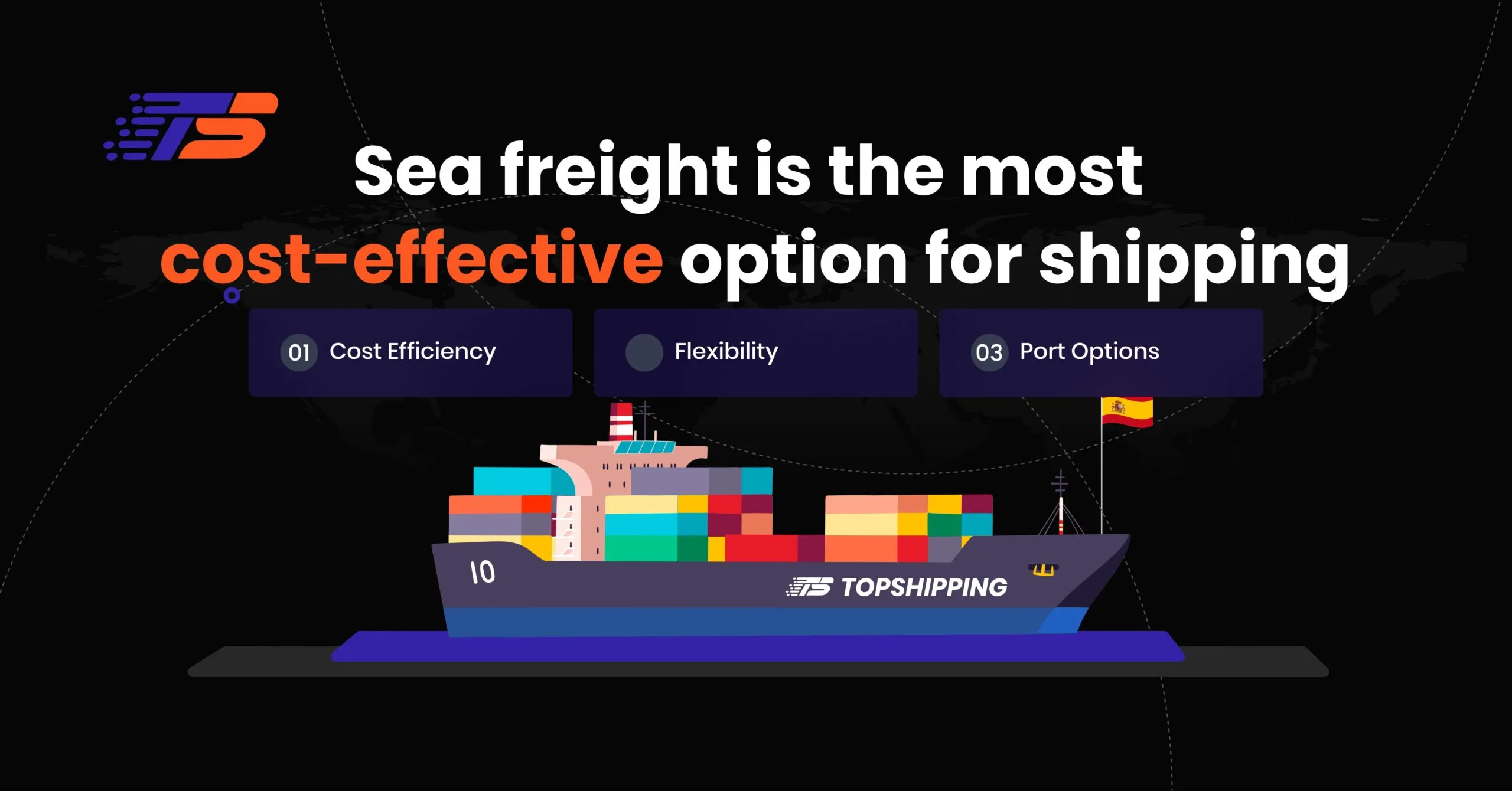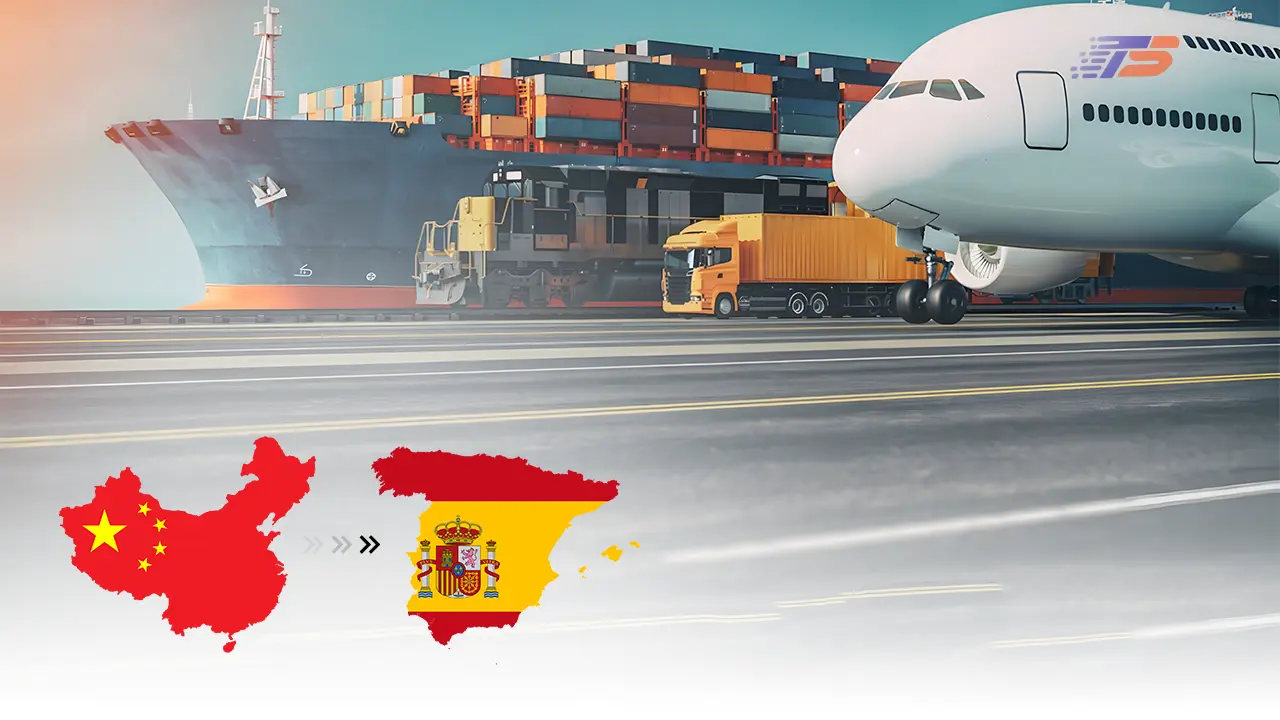In 2024, Spain imported $46.6 billion worth of goods from China, making it one of the top European destinations for Chinese exports. This momentum continues in 2025, as demand for shipping from China to Spain remains strong across industries such as consumer electronics, textiles, and machinery.
Looking ahead, 2025 is expected to bring shorter transit times and more competitive rates as shipping networks adapt to higher volumes. Still, global trade policies and market fluctuations may influence final costs. For B2B importers, this creates a favorable environment to plan shipments from China to Spain with greater confidence.
Shipping from China to Spain: Latest Costs & Delivery Times (Oct 2025)
Looking to ship goods from China to Spain with confidence? TopShipping offers end-to-end logistics solutions tailored to your cargo needs. Get competitive prices, reliable transit times, and seamless customs clearance with our expert team.
Costs (2025 Estimates)
- Air freight (≥ 1,000 kg): ~ $4.30 / kg
- Sea freight (20′ FCL to Spain ports): ~ $2,100
- Sea freight (40′ FCL to Spain ports): ~ $2,800
- Rail freight (40HQ to Madrid): ~ $8,300
- Rail LCL / per m³ (to Madrid): ~ $215 / m³
Delivery Times
| Mode | Route / Notes | Transit Time |
| Sea | China → Spanish ports (e.g. Barcelona / Valencia) | ~ 25–30 days |
| Air | Airport-to-airport (China → Spain) | ~ 4–7 days |
| Rail | China → Madrid via Eurasian rail line | ~ 18–22 days |
Optimal Shipping Method From China to Spain
When deciding among shipping methods for China to Spain routes, focus first on your business priorities: cost control, delivery reliability, and timing certainty. Think about whether your inventory cycles allow waiting longer or require faster replenishment. Consider the balance among freight cost, risk of delays, and how critical on-time arrival is for your revenue.
| Method | Transit Time Estimate | Best For |
| Sea (FCL / LCL) | ~ 25 to 40 days (port to port) | Bulk orders, heavy or low-value cargo |
| Rail / Intermodal | ~ 18 to 22 days | Medium-volume shipments with moderate urgency |
| Air Freight | ~ 3 to 8 days | High-value, time-sensitive goods |
| Express Courier | ~ 2 to 5 days | Small parcels, urgent deliveries |

Container Types for Ocean Freight
The container type directly affects both shipping costs and handling efficiency. Each option is designed to support specific cargo requirements, from oversized machinery to lightweight consumer goods.
| Container Type | Internal Dimensions (L × W × H) | Max Volume (CBM) | Best Use Case |
| 20′ Standard | 5.89 m × 2.35 m × 2.36 m | ~33 m³ | General cargo, medium loads |
| 20′ High Cube | 5.89 m × 2.35 m × 2.69 m | ~37 m³ | Cargo requiring extra height |
| 40′ Standard | 12.05 m × 2.35 m × 2.36 m | ~66 m³ | Large shipments with average weight |
| 40′ High Cube | 12.05 m × 2.35 m × 2.69 m | ~76 m³ | Maximizing cubic capacity for bulky cargo |
| 20′ Open Top | 5.89 m × 2.35 m × 2.36 m | ~32 m³ | Tall or oversized goods loaded from above |
| 40′ Open Top | 12.05 m × 2.35 m × 2.36 m | ~66 m³ | Large, tall cargo requiring top loading |
| 20′ Flat Rack | 5.89 m × 2.35 m × 2.23 m | ~30 m³ | Oversized machinery or heavy industrial parts |
| 40′ Flat Rack | 12.05 m × 2.35 m × 2.23 m | ~63 m³ | Large equipment, construction materials |
International Door-to-Door Delivery
Door-to-door delivery from China to Spain provides a single streamlined process where cargo is picked up at the supplier’s location in China and delivered directly to the buyer’s facility in Spain. Customs clearance, inland transport, and last-mile handling are integrated into one chain of responsibility, reducing the risk of delays or miscommunication. This approach is often favored by importers who need predictable lead times and minimal coordination across multiple carriers.
Amazon FBA Shipping
For sellers supplying Amazon Spain, specialized FBA shipping services ensure goods are transported from Chinese factories directly to designated Amazon fulfillment centers. This process includes labeling, packaging compliance, customs documentation, and timed delivery slots required by Amazon warehouses. Working with a logistics partner experienced in FBA standards allows sellers to avoid costly rejections, keep inventory flowing smoothly, and maintain stock levels aligned with sales demand.
Estimating Transit Times for China to Spain Shipments
Time is money especially in business. We offer transit time optimization by recommending the best routes and modes of transport based on your schedule and budget. Whether you need fast air freight or cost-effective sea freight, our logistics experts design the most efficient route to meet on time.
| Shipping Method | Transit Time (Port/Airport → Port/Airport) | Customs Clearance & Handling | Total Estimated Delivery Time (Door-to-Door) | Best Suited For |
| Sea Freight (FCL) | ~25–30 days | 3–5 days | ~30–35 days | Bulk cargo, stable demand |
| Sea Freight (LCL) | ~28–35 days | 4–6 days | ~35–40 days | Smaller shipments, cost efficiency |
| Rail Freight | ~18–22 days | 3–4 days | ~22–26 days | Medium-volume loads, balanced speed/cost |
| Air Freight | ~4–7 days | 2–3 days | ~6–10 days | High-value, urgent cargo |
| Express Courier | ~2–5 days | 1–2 days | ~3–7 days | Small parcels, e-commerce orders |
What Factors Affect Transit Time China-Spain
- Port and Airport Congestion: seasonal peaks or strikes can extend handling times.
- Customs Procedures: incomplete paperwork or inspections add extra days.
- Shipping Mode: sea, air, rail, and courier each carry different lead times.
- Weather Conditions: storms or rough seas delay vessels and flights.
- Route Selection: direct vs. transshipment ports influence overall speed.
- Holiday Seasons: Chinese New Year, Golden Week, and European holidays often slow down operations.
Shipping Costs & Transparent Pricing (China–Spain)
| Service Type | Cost Range (USD) | Minimum Charge | Best For | Estimated Transit Time (Door-to-Door) |
| Sea Freight (FCL – 20′) | $1,250 – $1,600 per container | One full unit | Bulk cargo, large-volume importers | ~30–35 days |
| Sea Freight (FCL – 40′) | $1,800 – $2,400 per container | One full unit | High-volume B2B shipments | ~30–35 days |
| Sea Freight (LCL) | $55 – $75 per CBM | ~1–2 CBM | Smaller loads, cost-sharing | ~35–40 days |
| Rail Freight (LCL/FCL) | $8,500 – $9,800 per container | One full unit | Balanced cost/speed for EU imports | ~22–26 days |
| Air Freight (Standard) | $4.50 – $7.00 per kg | ~45–100 kg | High-value or urgent cargo | ~6–10 days |
| Express Courier (DHL/UPS/FedEx) | $8 – $12 per kg | ~0.5–1 kg | E-commerce parcels, samples | ~3–7 days |
Shipping Cost Example: 200 kg Household Appliances from Guangzhou to Madrid via Standard Air Freight
- Base Freight Cost: ~$860 (200 kg × $4.30/kg)
- Fuel Surcharge (BAF): ~$70
- Customs Clearance (Spain): ~$60
- Handling & Documentation Fees: ~$45
- Total Cost: ~$1,035
- Transit Time: ~7–9 days
Factors Affecting Shipping Costs from China to Spain
- Mode of Transport: sea is cheapest, air and express are fastest but costlier.
- Cargo Weight & Volume: larger shipments lower unit cost; small parcels have high per-kg rates.
- Route & Carrier Choice: direct sailings vs. transshipment, premium airlines vs. economy.
- Seasonality: peak seasons (Chinese New Year, Q4 holidays) increase rates significantly.
- Customs & Duties: taxes, inspections, and documentation add to the final bill.
- Fuel Surcharges & Market Rates: bunker adjustment factors (BAF) and fuel volatility influence ocean/air prices.
Most Common Shipping Routes Between China and Spain
Optimize your China-Spain shipments by choosing the right routes from key Chinese hubs to Spain’s main ports. Streamline transit, reduce costs, and ensure timely delivery for your business cargo.
Major Departure Ports in China
- Shanghai Port: One of the world’s busiest container ports, handling over 50 million TEUs annually, serving as a central gateway for Europe-bound shipments.
- Shenzhen Port: Major southern China hub with modern container facilities, high throughput, and streamlined processing for international trade.
- Ningbo-Zhoushan Port: Connected to more than 90 countries and 560 ports worldwide, offering specialized terminals for containerized and bulk cargo.
- Qingdao Port: Key northern China maritime hub providing comprehensive logistics services and efficient container handling.
- Tianjin Port: Strategic northern gateway serving the Beijing region, equipped with advanced terminals and multimodal transport links.
Primary Arrival Ports in Spain
- Barcelona Port: Spain’s largest container port in the Mediterranean, with extensive connections to Asia and advanced logistics infrastructure.
- Valencia Port: Major southern hub handling high volumes of container and bulk shipments, known for efficient customs processing.
- Algeciras Port: Strategic transshipment center connecting Asia-Europe maritime routes, ideal for consolidation shipments.
- Bilbao Port: Northern Spain gateway supporting industrial and commercial cargo with modern container and warehousing facilities.
- Sagunto Port: Specialized in bulk and general cargo, providing flexible handling options for importers from China.
Air Freight Hubs (China and Spain)
- China: Beijing Capital & Daxing, Shanghai Pudong, Guangzhou Baiyun, Shenzhen Bao’an, key nodes for time-sensitive cargo.
- Spain: Madrid–Barajas, Barcelona–El Prat – main airports for international freight with full customs and cargo handling services.
Efficient Route Combinations
- Direct Sea Freight: Shanghai → Barcelona / Valencia, ideal for bulk shipments and predictable transit times.
- Consolidated LCL Shipments: Shenzhen / Ningbo → Valencia (via transshipment ports), cost-effective for smaller cargo.
- Rail + Truck: Chengdu / Zhengzhou → Madrid, faster than sea freight for medium-volume shipments using Eurasian rail corridor.
- Air Freight: Guangzhou / Shanghai → Madrid / Barcelona, airport-to-airport delivery for high-value or urgent goods.
- Express Courier: Shenzhen / Shanghai → Madrid / Barcelona, fastest option for small parcels, samples, or e-commerce shipments.
Customs, Duties, and Insurance Essentials for China to Spain Freight
Navigating customs, duties, and insurance is a critical part of importing from China to Spain. Businesses must ensure accurate HS code classification, proper documentation, and compliance with Spanish import regulations to avoid delays and unexpected costs. Duties and VAT vary by product type and value, making careful calculation essential for budgeting.
Additionally, selecting the right cargo insurance protects shipments against loss or damage, mitigating financial risk. By proactively managing these factors, companies can streamline clearance processes, maintain supply chain reliability, and safeguard their investments during transit.
Spain Customs & Import Duties
As an EU member state, Spain follows the customs regulations of the European Union that involve stringent product labeling, safety, and documentation standards. Your product has to meet EU directives, CE marking (where applicable), and product-related import restrictions. Duties is levied as a percentage of the customs value and varies depending on the nature of the product.
TOPSHIPPING helps you accurately estimate these charges in advance so that you are not taken aback. you can also use our logistic calculators to quickly estimate total shipping costs, including duties, taxes, and insurance, ensuring full visibility and better budgeting for your shipments.
Cargo Insurance Protection
Cargo insurance covers loss, theft, or damage during transit. For high-value shipments, insuring 110–120% of the invoice value is recommended to protect your investment. Do not neglect transportation insurance fees. Although optional, shipping insurance is highly recommended to protect your merchandise during shipment.
Cargo Documentation Checklist
To avoid customs or port delays, the right documents are essential. A rapid cargo documentation checklist is as follows:
- Commercial Invoice
- Packing List
- Bill of Lading / Air Waybill
- Certificate of Origin
- Import License (if required)
- Insurance Certificate (if required)
HS Codes for China-Spain Shipping
Harmonized System (HS) codes categorize goods for customs processing and duty calculation. Correct HS codes are essential to avoid delays, fines, or misclassification.
Understanding Incoterms and Delivery Options for China to Spain
Common Incoterms include DDP (Delivered Duty Paid) and DDU (Delivered Duty Unpaid). DDP ensures all duties and taxes are paid by the seller, simplifying delivery for the importer, while DDU shifts customs responsibility to the buyer. Door-to-door services, air, sea, or rail shipping can all be aligned with the chosen Incoterm.
DDP vs DDU: Best Shipping Terms for China to Spain
- DDP: Ideal for importers prioritizing convenience and predictable costs; all customs, VAT, and duties handled by the forwarder.
- DDU: Suitable for experienced importers who prefer to manage duties themselves to potentially reduce costs.
International Freight Forwarder from China to Spain
A reliable freight forwarder streamlines shipments from China to Spain by managing documentation, customs clearance, and transportation. For B2B importers, working with an experienced forwarder ensures predictable transit times, compliance with Spanish import regulations, and efficient coordination across multiple shipping modes—sea, air, or express courier. Forwarders also consolidate shipments, provide real-time tracking, and support DDP or DDU arrangements, reducing operational complexity for businesses importing high volumes.
How to Choose the Right Freight Forwarder
Effective collaboration with a forwarder requires evaluating responsiveness, network coverage, and expertise in Spanish customs and VAT compliance. Key considerations include:
- Proven experience with Europe-bound shipments and knowledge of EU trade regulations.
- Transparent pricing, including customs, duties, and handling fees.
- Ability to manage multiple shipping modes (sea, air, rail) and offer door-to-door solutions.
- Real-time tracking and communication in English or other preferred languages.
- Support for commercial compliance, HS codes, and FBA-ready shipments if needed.
Tracking Solutions: Monitor Your China to Spain Cargo In Real Time
Real-time tracking allows importers to monitor their shipments from origin to destination, ensuring transparency and minimizing the risk of delays or miscommunication. Advanced tracking systems provide updates on customs clearance, in-transit status, and estimated delivery times, giving businesses better control over their supply chain.
Service-Based Tracking
- Air Freight: Hourly or daily updates with airport departure, arrival, and customs status.
- Sea Freight (FCL/LCL): Container location, port arrival, and discharge notifications.
- Rail Freight: Terminal-to-terminal tracking with transit milestones along the Eurasian corridor.
- Express Courier: Minute-by-minute parcel tracking from pickup to door-to-door delivery.
- Door-to-Door Services: Combined updates covering pickup, transit, customs, and last-mile delivery.
Other Important Considerations for China to Spain Shipping
Importers should account for cargo sensitivity, regulatory compliance, and special handling requirements to ensure smooth shipping and timely delivery.
Sensitive & Special Cargo Handling
- Temperature-controlled shipments for perishables or pharmaceuticals.
- Fragile goods requiring reinforced packaging and careful loading.
- High-value cargo insured for full invoice value.
- Hazardous materials shipped following international safety regulations.
- Oversized or irregular-shaped cargo requiring special equipment or permits.
Prohibited and Restricted Items
- Items banned under Spanish or EU law (e.g., certain chemicals, weapons, counterfeit products).
- Restricted goods requiring permits or licenses (e.g., pharmaceuticals, medical devices).
- Products subject to additional customs scrutiny (e.g., food, cosmetics, electronics).
- Non-compliant packaging or labeling that can delay clearance.
- Personal effects or non-commercial shipments not allowed under commercial freight rules.
Final Takeaways: Efficient Strategies for China to Spain Freight
Successful shipping from China to Spain depends on balancing cost, speed, and compliance. Sea freight suits bulk shipments, rail offers a faster alternative for EU-bound cargo, and air or express services ensure urgent deliveries. Partnering with an experienced freight forwarder simplifies customs clearance, DDP/DDU management, and real-time tracking. Proper HS codes, cargo insurance, and awareness of restricted items further reduce delays and risks. Choosing the right service for your shipment size and value ensures predictable delivery and smooth operations for importers.
FAQ: China to Spain Shipping
What is the fastest way to ship from China to Spain?
Air freight is the fastest option, taking 3–7 days. Express shipping via couriers like DHL or FedEx can deliver in as little as 1–4 days for urgent parcels.
What is the cheapest way to ship from China to Spain?
Sea freight is the most cost-effective method for bulk shipments, with rates starting at $2,000–$3,500 per 20ft container.
How long does shipping from China to Spain take?
Transit times vary:
- Express shipping: 1–4 days
- Air freight: 3–7 days
- Rail freight: 15–25 days
- Sea freight: 25–40 days
What are the customs duties and VAT in Spain?
Spain applies:
- VAT: 21%
- Duties: Varies by product HS code
How much does it cost to ship from China to Spain?
Shipping costs vary by method, weight, and volume. Air freight for a 100 kg shipment averages $6–$8 per kg, while sea freight for a 20′ container ranges $1,200–$1,500 depending on the port and season.
How much is shipping from China to Spain?
- For small parcels: $30–$50 via express courier.
- For mid-size shipments (500–1,000 kg): $3–$5/kg via air freight.
- For full containers (20′ or 40′): $1,200–$1,500 per 20′ container.
How much tax do I pay on imported goods from China?
Total import tax = Customs duty + VAT. For example, a product valued at $1,000 with a 3% duty: $30 duty + $213 VAT (21% on $1,030) = $243 total tax.
How much would it cost to ship a package to Spain?
- Small parcel: $30–$50 via express courier.
- Air freight (100 kg): ~$650–$700
- Sea freight (LCL, 1 CBM): ~$50–$70


